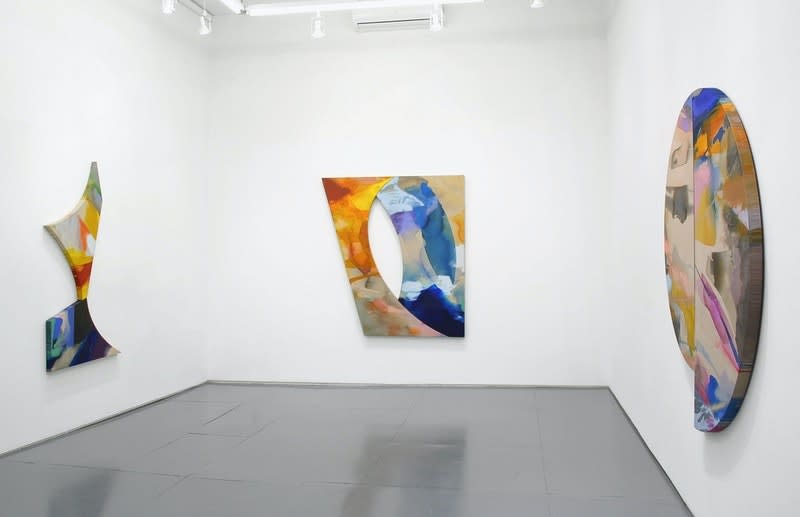“Reflector” comprises five, large-scale oil-on-linen paintings. They are variously shaped, and consist of two interrelated parts, like bodies embracing whilst moving through space, easily bringing to mind an improvised dance—figures in motion, relating, communicating, combining. Both the stained, intense color, and the shapes are dynamic. Jorden reacts moment to moment during the process of making each painting, improvising and responding along the way. Paint in this case is revealed to be the trace of actions taken on the material support, fluid and organic. This is in clear contrast to the other order of dynamism—the clear-cut shapes of each part of each diptych: profiles that offer a skewed geometry, rather than a static symmetry.
“Heliotrope” (2020), the title referring to a Heliotrope (from the Greek helios, sun, and tropos, movement), a plant that turns to face the sun, is apposite. The 72-inch diameter rondo has a vertical curved segment in its center, as the right side of the diptych is a half disc and the left side a crescent that fit together. There is a strong sense of sweeping movement, the body arcing, arms outstretched. Jorden avoids the use of painted, gestural brush marks that typify another California based artist, Mary Weatherford, though the two share an investment in keeping the paint and support, the exposed linen, or ground part of the image. “Spine” (2020), like the other paintings with a maximum vertical dimension of 72 inches, evokes human size, stance and motion. The fragmented, curvy angularity maintains an unexpected profile and brings to mind Katharina Grosse’s sculptural painted objects. Here, the stained warm upper section and cooler lower section do not simply receive the drawn, sprayed color from a distance as with Grosse. Rather, the paint here is pushed and dragged around and across on the surface by Jorden working close to, and moving in proximity with the shaped supports.
Looking at this group of paintings installed in a single room makes me think of Matisse’s Barnes mural. I think of Matisse negotiating the alcove shapes that the paintings of dancers had to use, and incorporate, in anything but a passive attitude—the resulting shapes, as in his cut-outs, reflect the dynamism of dance and music and shifting color as light: temporal experience. Jorden conveys the strong southern Californian light using bright and subdued, luminous color together with a physical sense of passage in the interlocking shapes of the support. This emphasis on meditation of movement: bodies in space, is new in Jorden’s work, and inspired by her friend, the artist Virginia Holt (1915–2015). They met after Jorden saw an exhibition of Holt’s paintings at the Jancar Gallery in Los Angeles and was later invited to visit Holt at home by the curator of the exhibition, Katy Crowe, a longtime friend of Holt’s. In the smaller front space of the gallery Jorden has curated a group of paintings and prints. The visual and conceptual discourse between the two artists’ work is extraordinary, complementary and, rare. Holt’s works are figurative, retaining direct association with human form and are consummately achieved works. Holt was very involved with music, performance and painting, and amongst the artists she counted as friends was another polymath Don van Vliet (Captain Beefheart). Jorden has continued this integration, or exploration of physical experience, of being embodied, into a visual form, where despite being ostensibly static the painting is anything but motionless. Painting conceived thus, projects philosophically the relation to the world we all experience, and dissolves categorical and inert positions in favor of both flux and continuity.


